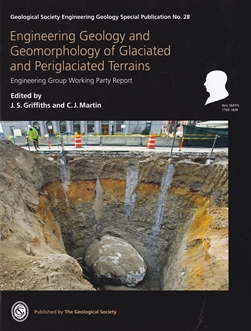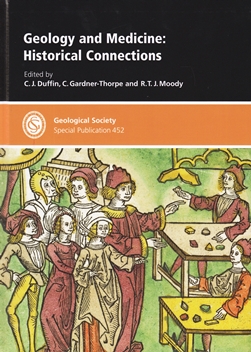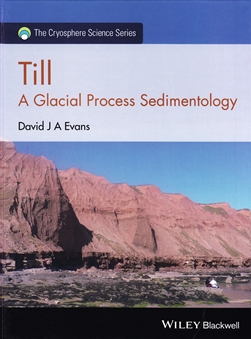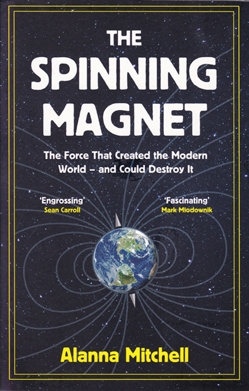 Engineering Geology and Geomorphology of Glaciated and Periglaciated Terrains
Engineering Geology and Geomorphology of Glaciated and Periglaciated Terrains
In 2010 the Engineering Geology Group set up a steering committee to review the current state of knowledge and art arising from former Quaternary periglacial and glacial ground conditions. The instruction was to provide a book with a strong emphasis on practical interpretation, while being concise and digestible.
This book is the result. It is quite simply a tour de force, a clear and complete synthesis of the combined disciplines of geomorphology, geotechnics and geology as they relate to glacial and periglacial terrains, rolled up into one rather handy bible. Mission accomplished!
The scope of the book follows a systematic description of types of sediments, structures, landforms and geomorphology of such terrains. This forms one third of the book, and amounts to an atlas and framework or ‘architecture’ of unconsolidated soils: a very significant undertaking. It has excellent photography and abundant cross referencing, to allow the practitioner to follow up a line of observation and reasoning.
This is followed by a detailed description of ground models, material properties and potential geohazards. In turn this provides a basis of specification for engineering investigation and assessment, design and construction considerations. This is accompanied by a variety of illustrative case studies taken from various parts of the world.
The central tenet of the work is that, through a conceptual ground-model approach, practitioners will be able to predict the likely materials that are liable to be encountered. Although, be warned, one can always find ways of seeing what one is expecting to see!
The language used is particularly noteworthy, as each of the disciplines has erstwhile evolved different terminologies; here, there has been an attempt to reconcile some of those differences. The result is both detailed and succinct, an example of a writing technique for other specialists to follow.
Examples are mainly taken from previously published sources, dominantly British and European; but there are some from North America and elsewhere, covering the Northern Hemisphere down to 40 degrees North; but the antipodes are not ignored.
In my view any geologist, engineering geologist or geotechnical specialist who is engaged in practical fieldwork, or the commissioning and interpretation of site investigation reports, ought to be making arrangements to place a copy of this book at their elbow.
Reviewed by Arthur Tingley
ENGINEERING GEOLOGY AND GEOMORPHOLOGY OF GLACIATED AND PERIGLACIAL TERRAINS by GRIFFITHS J S AND MARTIN C J (Eds) 2017 Geological Society Engineering Geology Special Publication No. 28. List Price: £120.00. Fellows Price: £60.00. W: https://www.geolsoc.org.uk/SPE28
 Photo Atlas of Mineral Psuedomorphism
Photo Atlas of Mineral Psuedomorphism
Traditionally, mineralogy books - like those of Sowerby, Rashleigh and Haüy - utilised pen and ink or watercolour images to illustrate minerals. Kirkaldy, in his famous Introduction book that for several generations of geologists was possibly their first introduction to minerals, used hand-specimen photographs - generally a little blurred!
However, the trend in 'serious' mineral text books has been to shy away from photographs as though they were a little vulgar. So, it is with pleasure I read this recent Photo Atlas of Mineral Pseudomorphism. Yes, there are excellent photographs of beautiful minerals, geological eye-candy; but the text is a scholarly discussion of pseudomorphs in the mineral kingdom.
Mineral pseudomorphs have been subject to several historical studies, but only a few scattered publications from the mid-20th Century onwards. The combination of a university academic and an international mineral dealer has been successful and produced a book that both entertains and educates.
The volume is not perfect. The introduction section is the educational thesis, and a little confusing in its organization - although well written and edited. However I think the following sections that are the ‘Atlas’ could have benefited from text discussing the nature of pseudomorphs specific to each of those discussed. A nice feature is that mineral photographs of the mineral doing the pseudomorphing and the mineral replaced are shown alongside the pseudomorph itself. Several important pseudomorphs are missing, for example native gold after calaverite from Cripple Creek, Boulder and Kalgoorlie.
But these small omissions aside this is an excellent first edition and I am sure will be reproduced as it should prove a popular book and perhaps even simulate new research on this interesting mineral phenomenon.
Reviewed by Rob Bowell
PHOTO ATLAS OF MINERAL PSEUDOMORPHISM by KLOPROGGE JT AND LAVINSKY R, 2018 Elsevier Press 290pp hbk Hardcover ISBN: 9780128036747 List price: £75.00. W: https://www.elsevier.com/books/photo-atlas-of-mineral-pseudomorphism/kloprogge/978-0-12-803674-7
 Archaeological Soil and Sediment Micromorphology
Archaeological Soil and Sediment Micromorphology
As witnessed by the work of Henry Sorby, a Sheffield ironmaster of independent means and a past-President of the Geological Society, the petrographic microscope was first used in geology in the 19th Century, revolutionising petrography. By the 1930s the instrument was being applied by soil scientists to large, resin-impregnated thin-sections of samples from soil horizons. Again, by the late 1950s and 1960s archaeologists were beginning to apply the petrographic microscope to archaeological deposits, but it was not until the 1970s that such work became at all widespread and systematic.
The new discipline was called ‘micromorphology’. It embraced the identification and evaluation of archaeological materials, the elucidation ancient technologies, and the understanding of archeological contexts and human impacts. The petrographic microscope remains central to these endeavours, but is now supplemented and expanded by a great variety of microscopic and instrumental techniques.
Central to micromorphology are natural materials, artefacts, and ‘ecofacts’. The most important natural materials are mineral grains, fragments of rock, coal, soils, soil spherulites, and biospheroids. Among the artefacts found in thin-section are fragments of worked stone, slags and metal-working debris, pottery, brick, earth construction materials, plasters and mortars. A great diversity of ecofacts are encountered: bones, teeth, fish scales, molluscan shells, microfossils, plant remains, seeds, dungs, parasite ova, charcoal, and ash. Most of these materials can be modified by fire, which may have been either natural or human in origin.
Work with these materials allows many central questions to be tackled, for example, the use of space (e.g. hearths, seasonal reflooring/replastering), location of routeways, the whereabouts and character of animal gathering enclosures, the effects of different agricultural methods (agricultural soils, dark earths), and activities in rock-shelters and caves.
Composed of 44 detailed papers by 52 mainly European authors, Nicosia and Stoops’ Archaeological Soil and Sediment Micromorphology is an impressive and appealing handbook and sourcebook on the materials, problems, techniques, achievement, and prospects of the subject. It is a pleasure to handle, with its large, double-column format, copious photomicrographs of the highest quality, and comprehensive reference lists. The subject clearly goes from strength to strength but, as the Editors are at pains to point out, is held back by the poor or non-existent background in geology possessed by many micromorphologists - a clear weakness, for example, in British archaeological education.
Reviewed by John R L Allen
ARCHAEOLOGICAL SOIL AND SEDIMENT MICROMORPHOLOGY by C NICOSIA and G STOOPS (Eds.) 2017. Published by: Wiley Blackwell, i-xix, 476 pp. ISBN: 9781118941058, List Price: £100. E-book: £90.99. W: https://www.wiley.com/en-gb/Archaeological+Soil+and+Sediment+Micromorphology-p-9781118941058
 Geology and Medicine: Historical Connections
Geology and Medicine: Historical Connections
In 2014 I reviewed SP375 A History of Geology and Medicine which was the first ever volume dedicated to this subject. That volume was the result of a conference convened by The History of Geology Group, held at Burlington House in 2011. The first meeting had been exploratory in its approach and it became obvious that the themes were worthy of further investigation. This led to a second meeting (November 2014) which forms the basis of this second volume under the same editorial team as before. (Interestingly I have spoken to two people recently who thought that this was just a ‘second edition’ of SP375, but this is definitely not the case!)
This volume explores the development and overlap of medical and geological sciences by an international group of authors that includes geologists, medical professionals and historians. There are some 19 papers with contributions from Italy, Spain, France, Switzerland, Greece, South America and a number from the UK.
Some of the historic personalities recorded are well known to many such as Nicolas Steno and James Parkinson, but there are other lesser-known contributors to our geological knowledge that include some of Italian ancestry who are acknowledged here for their contributions to geology. Many other names not so well known to geologists, such as Hodges, Sperling, Siques and Lemone, are also recorded for their contributions to our knowledge.
Two papers under the general theme of ‘Geotherapeutics’ explore the historical use minerals and ‘earths’ in curative medicine in the 17th and 18th Centuries. The paper dedicated to ‘Serpent Stones’ gives a fascinating historical view of their medical applications delving deep into antiquity, and if you read only one paper from this publication, it should be this one.
This is a well-produced volume of varied topics that examines the relationships between geology and medicine. It makes fascinating reading and once dipped into is compelling and even difficult to put down. The volume is well illustrated with many monochrome maps, figures and drawings of historic origin, but the lively text is also enhanced with many illustrations in colour.
It will be of specific interest to Earth scientists and those with an interest in the medical profession, be that as a medical professional or just as an interested individual. This volume will also appeal to the general reader with an interest in science. It will not disappoint and is highly recommended.
Reviewed by Richard Porter
GEOLOGY AND MEDICINE: HISTORICAL CONNECTIONS by DUFFIN C J; GARDNER-THORPE C; AND MOODY R T J, (Eds). 2017. Geological Society of London Special Publication 452. ISBN: 978-1-78620-283-3 (hbk) 304pp. List Price: £100. GSL Fellows: £50. Other Societies: £60. W: www.geolsoc.org.uk/SP452
 Atlas of Natural and Induced Fractures in Core
Atlas of Natural and Induced Fractures in Core
Practical publications in the geosciences have always been welcome particularly when they are an ‘Atlas’-type approach, geology being a very visual science. So, this recent AAPG publication, which focuses on cataloguing the nature of fractures in drill core will have value in many sectors of applied geology.
The volume provides visual representation with brief explanation of the different physical features observed in core, be it natural or artefact of mining. The natural and induced fracture data contained in cores provide a wealth of information, once they are recognised and properly interpreted. Written by two experts in the field, this resource provides a much-needed tool to help with the accurate interpretation of these cores.
The Atlas demonstrates how to recognise non-fracture artefacts in a core since many of them provide other types of practical information. The visual catalogue of fractures and artefacts is an invaluable guide, particularly for less experienced core logger. Too many times artefacts are not recognised, and labelled with lavish description and interpretation - leading to confusion and erroneous logging.
Presented in full colour and free of obvious errors, this is a high quality publication that should be an essential text in any and all core facilities and essential reading for anyone who spends time looking at core.
Reviewed by Rob Bowell
ATLAS OF NATURAL AND INDUCED FRACTURES IN CORE by JOHN C LORENZ AND SCOTT P COOPER 2017. ISBN (print) 9781119160007. Online DOI: DOI: 10.1002/9781119160014. 328pp (hbk) List Price: £120.00. W: https://www.wiley.com/en-gb/Atlas+of+Natural+and+Induced+Fractures+in+Core-p-9781119160007
 Till: A Glacial Process Sedimentology
Till: A Glacial Process Sedimentology
The author, David Evans, has brought together a comprehensive summary of the available data for till. The target audience for this book consists of researchers and specialists in glacial science and sedimentology. It covers a vast literature, including experimental and laboratory based reviews and assessments, in addition to comprehensive field studies. It is immediately evident that it comprises many hours of rewarding work from the author and colleagues. The book is built from international research in an attempt (among other things) to answer the simple but deceptively difficult-to-answer question: what exactly should be called ‘till’?
Each chapter begins with a helpful quote, from contemporary glacial scientists and even a former British Prime Minster. An early chapter outlining the history of till research is a welcome addition to the literature, providing a summary of research to date covering the adoption of the word 'till' as a geological term in 1863 through to the prevalence (and subsequent decline) of the alternative term, 'boulder clay'.
Although relatively short, an early discussion on the appropriate usage of ‘till’ helps shape and dictate the direction of subsequent chapters. An overview of the literature on glacial processes and suggested classifications is provided, including from the Glacial Working Group. The author builds upon previous recommendations of fellow glacial sedimentologists to develop a threefold classification system of till as generic terms, including: ‘glacitectonite’, ‘subglacial traction till’, and ‘melt-out till’. In establishing a simple and systematic nomenclature, future objective assessments of glacigenic deposits can be undertaken.
One personal quibble with the book relates to the editing – specifically, to the placement of references within sentences. In certain chapters, within the main text, the location of so many such references adversely affected my flow as a reader. For example, references distended one sentence to cover more than four pages! This is, perhaps, a minor comment, and perhaps would not be so off-putting to readers more familiar with the subject matter. It does not detract from the overall scientific quality of the book.
If you are looking for a text that brings together a detailed review of the current state of ‘till science’, then this book is highly recommended - as a useful source of reference. It is hardly a light read, however.
Reviewed by Giles Bushell
TILL: A GLACIAL PROCESS SEDIMENTOLOGY by DAVID J A EVANS, 2017. Published by: Wiley-Blackwell cryosphere science series (HBK) ISBN: 978-1-118-65259-6 List Price: £95.00. W: https://www.wiley.com/en-gb/Till:+A+Glacial+Process+Sedimentology-p-9781118652596
 The Spinning Magnet
The Spinning Magnet
This intriguing and fascinating book delves into all corners of research behind electromagnetism. It is great for anyone who, as well as learning about geological concepts, also loves to learn about how they came to be and the amazing people who came up with them.
Mitchel goes into riveting detail. She discusses long-forgotten scientists who are rarely mentioned today. A scientific timeline is created leading up to what we know now, as well as offering a glimpse into a future where poles have reversed.
The book is excellent at explaining some basic ideas such as the geodynamo; however if you want a more in-depth telling of the science you might be a little disappointed. However, had Mitchell gone into greater detail this book would be a couple of extra hundred pages long! Her in-depth reporting is evident; going on an adventure with Jacques Kornprobst through central France, exploring where Bernard Brunhes made the discovery that the poles had once switched places by looking at reheated terracotta.
She touches on why Brunhes remains so long forgotten. She ends with a discussion with Daniel Baker of the University of Colorado, asking what would happen if a solar storm struck astronauts on the moon (dig a hole and lie down on it, the junior on top, hoping that at least one might make it back alive!). She also asks what a future would be like where we were heavily affected by a magnetic pole reversal.
Mitchel’s reporting skills are evident and she doesn’t hold back - travelling anywhere she can get some answers. I urge you to buy this book now, as it holds the most up-to-date information. Some might say this book even offers something of a warning that we face a dangerous and treacherous future bathed in solar radiation.
Reviewed by Eleanor Dunn
THE SPINNING MAGNET: THE FORCE THAT CREATED THE MODERN WORLD – AND COULD DESTROY IT by ALANNA MITCHELL, 2018. Published by: Oneworld 277pp (pbk) ISBN: 978-1-78607-424-9 List price: £16.99 W: www.oneworld-publications.com